

The star of my collection, and my first Bliss item. This chronometer is mounted in a typical three-tier rosewood box which I believe to be original. It has been refinished, and has old repairs. The round ivory label is original, left blank for the owner's name or ship, as was common at the time. The winding key appears to be original. There is a key for the box lock, and the lock works. Box is 7-1/4 in. deep by 7-1/4 in. wide by 7-1/2 in. high.
|
|
|
3-7/8 in. diameter 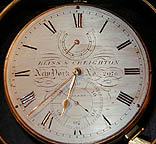 |
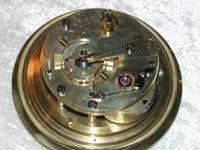 |
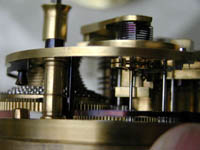 |
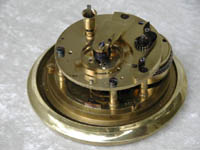 |
|
|
BLISS & CREIGHTON #2076
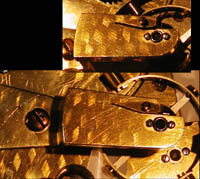 |
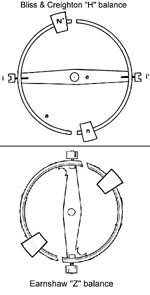 This chronometer
has the "H" shaped balance (as opposed to the standard
Earnshaw "Z" balance) patented by John Bliss & Frederick
Creighton in August of 1945. Physically this resembles the modern
"Integral" balance, but the materials used are different,
so the operation is not the same. The patent, #4135 dated Aug.
4, 1845, was probably at least one subject of the lawsuit between
the former partners after they split up. Both of the successor
firms, Creighton & Black and John Bliss & Son, used the
balance in their chronometers. In addition to the "H"
shape of the balance, designed to correct for middle temperature
error, the patent also had a claim for "the application of
a second balance spring above, below, or inside the single balance
spring heretofore in use...to insure a more equal rate of going..."
by averaging out any physical inequalities in the two springs.
This second claim did not deal with the middle temperature error,
and may never have been fitted to any chronometers. All Bliss
& Creighton chronometers I've seen from SN#1036 onward have
the "H" balance, but I've never seen the double balance
spring.
This chronometer
has the "H" shaped balance (as opposed to the standard
Earnshaw "Z" balance) patented by John Bliss & Frederick
Creighton in August of 1945. Physically this resembles the modern
"Integral" balance, but the materials used are different,
so the operation is not the same. The patent, #4135 dated Aug.
4, 1845, was probably at least one subject of the lawsuit between
the former partners after they split up. Both of the successor
firms, Creighton & Black and John Bliss & Son, used the
balance in their chronometers. In addition to the "H"
shape of the balance, designed to correct for middle temperature
error, the patent also had a claim for "the application of
a second balance spring above, below, or inside the single balance
spring heretofore in use...to insure a more equal rate of going..."
by averaging out any physical inequalities in the two springs.
This second claim did not deal with the middle temperature error,
and may never have been fitted to any chronometers. All Bliss
& Creighton chronometers I've seen from SN#1036 onward have
the "H" balance, but I've never seen the double balance
spring.

This chronometer has several interesting features. The up-down indicator moves through an arc of only 282°, rather than the 310° or so of every other chronometer I've seen, including older Bliss & Creighton instruments, and all other Bliss instruments. Compare it to the up-down indicator on my John Bliss & Co. #3086.
Also, at first glance, the plates and surfaces of the movement appear to be plain metal, without the spotting or decoration common to chronometers. If one gets the light right, however, a subtle pattern of diamonds is revealed. I believe, in keeping with their 1848 claims, that this chronometer was made entirely in America by Bliss & Creighton, and that it was made in their last year before they dissolved their partnership in 1853.